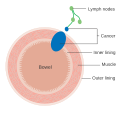Colon cancer staging
Definitive staging can only be done after
TNM staging system
The most common staging system is the
Tumor (T)

Numbers 0 to 4, with subgroups, are used to describe deepest tumor depth:[2]
- TX: The primary tumor cannot be evaluated.
- T0: No evidence of cancer in the colon or rectum.
- Tis: Carcinoma in situ; Cancer cells are found only in the epithelium or lamina propria
- T1: Growth into the submucosa
- T2: Growth into the muscularis propria
- T3: Growth through the muscularis propria and into the subserosa, or into tissues surrounding the colon or rectum (but not the visceral peritoneum or surrounding organs).
- T4a: Growth into the surface of the visceral peritoneum.
- T4b: The tumor has grown into or has attached to other organs or structures.
Node (N)
Numbers 0 to 2, and subgroups, are used to describe lymph node involvement:[2]
- NX: The regional lymph nodes cannot be evaluated.
- N0: No evidence of spread to regional lymph nodes.
- N1a: Tumor cells found in 1 regional lymph node.
- N1b: Tumor cells found in 2 or 3 regional lymph nodes.
- N1c: There are cancerous nodules near the colon that do not appear to be lymph nodes.
- N2a: Tumor cells found in 4 to 6 regional lymph nodes.
- N2b: Tumor cells found in 7 or more regional lymph nodes.
Metastasis (M)
Numbers 0 and 1, with subgroups, describe the metastasis status:[2]
- M0: No evidence of distant metastasis
- M1a: Spread to 1 other part of the body beyond the colon, rectum or regional lymph nodes.
- M1b: Spread to more than 1 part of the body other than the colon, rectum or regional lymph nodes.
- M1c: Spread to the peritoneal surface.
Overall AJCC stage
AJCC stage[2]
|
TNM stage[2] | TNM stage criteria[2] |
|---|---|---|
| Stage 0 | Tis N0 M0 | Tis: Tumor confined to mucosa ; cancer-in-situ
|
| Stage I | T1 N0 M0 | T1: Tumor invades submucosa |
| T2 N0 M0 | T2: Tumor invades muscularis propria
| |
| Stage II-A | T3 N0 M0 | T3: Tumor invades subserosa or beyond (without other organs involved) |
| Stage II-B | T4a N0 M0 | T4a: Tumor perforates the visceral peritoneum |
| Stage II-C | T4b N0 M0 | T4b: Tumor invades adjacent organs |
| Stage III-A |
|
|
| Stage III-B |
|
|
| Stage III-C |
|
|
| Stage IVa | any T, any N, M1a | M1a: Metastasis to 1 other part of the body beyond the colon, rectum or regional lymph nodes. Any T, any N. |
| Stage IVb | any T, any N, M1b | M1b: Metastasis to more than 1 other part of the body beyond the colon, rectum or regional lymph nodes. Any T, any N. |
| Stage IVc | any T, any N, M1c | M1c: Metastasis to the peritoneal surface. Any T, any N. |
Dukes classification
In 1932 the British
- Dukes A: Invasion into but not through the bowel wall
- Dukes B: Invasion through the bowel wall penetrating the muscle layer but not involving lymph nodes
- Dukes C: Involvement of lymph nodes
- Dukes D: Widespread metastases[7]
Astler-Coller classification
An adaptation by the Americans Astler and Coller in 1954 further divided stages B and C[8][9]
- Stage A: Limited to mucosa
- Stage B1: Extending into muscularis propriabut not penetrating through it; nodes not involved
- Stage B2: Penetrating through muscularis propria; nodes not involved
- Stage B3: Invading into adjacent organs/structures; nodes not involved
- Stage C1: Extending into muscularis propria but not penetrating through it. Nodes involved
- Stage C2: Penetrating through muscularis propria. Nodes involved
- Stage D: Distant metastatic spread
The stage gives valuable information for the prognosis and management of the particular cancer. [citation needed]
Full Dukes classification
Another modification of the original Dukes classification was made in 1935 by Gabriel, Dukes and Bussey.[10] This subdivided stage C. This staging system was noted to be prognostically relevant to rectal and colonic adenocarcinoma.[11] Stage D was added by Turnbull to denote the presence of liver and other distant metastases[12]
- Stage A: Limited to muscularis propria; nodes not involved
- Stage B: Extending beyond muscularis propria; nodes not involved
- Stage C: Nodes involved but highest (apical) node spared
- Stage D: Distant metastatic spread
-
Dukes stage A bowel cancer; the cancer is only in the inner lining of the bowel.
-
Dukes stage B bowel cancer; the cancer has invaded the muscle.
-
Dukes stage C bowel cancer; the cancer has invaded the nearby lymph nodes.
-
Dukes stage D bowel cancer; the cancer has metastasized.
References
- ^ "Cancer Staging". American Cancer Society. Retrieved 12 Sep 2020.
- ^ ISSN 0007-9235.
- ^ Who Named It, showing correct grammatical usage
- ^ Kyriakos M: The President cancer, the Dukes classification, and confusion, Arch Pathol Lab Med 109:1063, 1985
- ^ Dukes CE. The classification of cancer of the rectum. Journal of Pathological Bacteriology 1932;35:323
- ^ AJCC (American Joint Committee on Cancer) Cancer Staging Manual, 7th ed, Edge, SB, Byrd, DR, Compton, CC, et al (Eds), Springer, New York 2010. p 143.
- ISBN 9780340972359)
- ^ Astler VB, Coller FA: The prognostic significance of direct extension of carcinoma of the colon and rectum. Ann Surg 139:846, 1954
- PMC 9409470. Retrieved 19 November 2022.
- ^ Gabriel WB, Dukes C, Busset HJR: Lymphatic spread in cancer of the rectum. Br J Surg 23:395–413, 1935
- ^ Grinnell RS: The grading and prognosis of carcinoma of the colon and rectum. Ann Surg 109:500-33, 1939
- ^ Turnbull RB Jr, Kyle K, Watson FR, et al: Cancer of the colon: the influence of the no touch isolation technique on survival rates. Ann Surg 166:420-7, 1967




